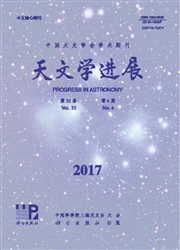

 中文摘要:
中文摘要:
简述基本物理中引力试验的概况,特别是检测试验粒子绕中央旋转天体引起LenseThirring(LT)效应的研究进展。给出自旋质点在旋转体引力电磁(Gravitoelectromagnetism,GEM)中运动的Schiff公式。描述了检测地球LT效应的各种方法:激光测卫、GP-B、激光测月和环形激光陀螺,特别叙述了环形激光陀螺仪在地球科学上的应用,如地震、潮汐、地球自转、极移的检测,并给出了正在进行和未来更高精度测定LT效应的LARES、OPTIS等计划。叙述了检验火星LT效应的情况,包括用MGS测距资料、火星自然卫星Phobos和Deimos观测资料,以及今后发射绕火星探测器的建议。也谈及用太阳系行星(水星、金星、火星)测定太阳LT效应和未来采用国际空间站进行相对论检验的LATOR计划。最后,简述在脉冲双星、X射线双星和银心Sgr A*附近红外S系统恒星中引力场的广义相对论效应,以及我国开展该项工作的情况和提出的建议。
 英文摘要:
英文摘要:
The general situation of gravitational experiments in the fundamental physics,especially the progress of measuring the Lense-Thirring effect induced by a test particle orbiting around a central rotating body, such as the Earth, is outlined. The Schiff formula which is a fundamental formula to describe the motion of a particle in the Gravitoelectromagnetic(GEM) field of a central rotating body, is given. Various methods, such as Satellite Laser Ranging(SLR), GP-B, Lunar Laser Ranging(LLR) and Ring Laser Gyroscope(RLG), to measure the Lense-Thirring effect are introduced. Especially, the application in Geophysics with RLG, such as earthquake, tide, earth rotation, polar motion, is presented. The present and future planes to measure the Lense-Thirring effect in high accuracy, such as LARES,OPTIS etc. are introduced. The situation of measuring Lense-Thirring effect of Martian gravitational field with MGS Doppler and range data or observing data of Martian natural satellites, Phobos and Deimos is indicated. The suggestion to lunch Martian mission in the future is also given. The measurement of the Lense-Thirring in Solar Gravitomagnetic field is described with the presently available planetary ranging to Mercury, Venus and Mars.The future plan LATOR to test the general theory of relativity is introduced with the International Space Station(ISS). Finally, The general relativity effect of gravitational field in binary pulsar, X-ray binary and the system of S-stars in infrared band near the Galactic center Sgr A* is briefly introduced. The situation about the experiments to confirm the relativistic theory in China with the tracking and ranging data in the planetary space and some suggestions to develop this work are mentioned.
 同期刊论文项目
同期刊论文项目
 同项目期刊论文
同项目期刊论文
 期刊信息
期刊信息
